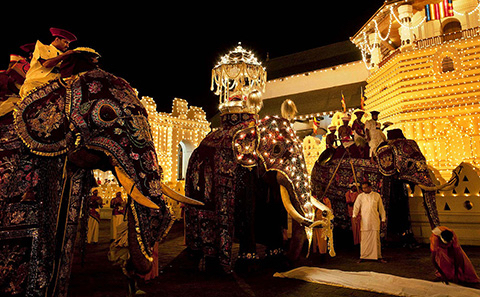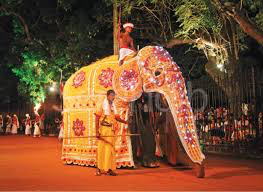Elephants have always been a treasure to Sri Lanka since ancient days. People of Sri Lanka share an extraordinary relationship with elephants and it spans nearly 2500 years according to the Mahawansa. They have played an important role in the history of Sri Lanka and still bears a prestigious place in our culture and religion.
Perahera, especially talking about the Esala perahera, is one of the most glamorous occasions in the Buddhist culture in which elephants are being made a part of. While the spectators enjoy all the items in the perahera, one would notice that most of the elephants dance to the beat of the drums as well. Do they actually feel the music and have the rhythm in their body?
It has been proven that elephants are not really dancing to the beat of the drums but they are showing a different behavior instead. These rhythmical body movements often synchronize with the drum beats played in the perahera and people assume it to be ‘ali natum’ meaning elephant dance. Elephants lightly swing their trunk and head in a figure “8", flap their ears back and forth, sway their tail, sway their trunk and head side to side, head bobbing up and down, and move their body side to side with usually one foot off the ground (fore foot). There is a reason behind all these behaviors.
Elephants are wild animals who enjoy hunting and roaming long distances. Once they are brought under captivity they display certain behavioral patterns which are not displayed by wild elephants. These are considered as stereotypic behaviors. Stereotypic behavior is defined as a repetitive body movement or repetitive movement of objects that has no obvious function. The frequent types of stereotypic behaviors exhibited by elephants are weaving (repetitive swinging of trunk and head from side to side), head bobbing (repetitive movement of head up and down), weaving while lifting one foot (usually the fore foot).
This is a surrogate activity caused by boredom, frustration and desolation. Wild elephants are always occupied with activities relating to their survival. Elephants in captive become bored and they start displaying stereotypic behaviors to be preoccupied. It also reduces the social interactions they share with other elephants and often become mentally distressed. It should be in the interest of every elephant owner to offer to his or her animals an interesting and varied life that is appropriate to the species.
Elephants that participate in these annual pageants exhibit stereotypic behaviors due to distress. In order to get to the temple, elephants have to walk miles on the tarred roads in the scorching sun and if ‘fortunate’ would get a ride in the back of a truck but in the hot blazing sun, chained. Although elephants are known to travel long distances, it is at its own pace. Elephants also suffer the weight and discomfort of the robes, capes, ornaments and battery powered electric bulbs that cover their entire body and large ears that usually lower the body temperature. As they march down, the costumes that shift will hinder their vision. The mahout either sits on the elephant poking it or walks by the side of the elephant pulling the chains or poking with the elephant goad. All these have caused a frustration to the elephant and therefore, exhibits those stereotypic behaviors.
Another reason behind these stereotypic behavior could be due to musth behavior of male (bull) elephants. Musth behavior is a form of reproductive behavior which is a state of heightened aggressiveness. An elephant who goes into musth often dribble urine continuously and have a thick black secretion from their temporal glands (the duct from the temporal gland opens between the eye and the ear). These elephants have a high level of testosterone in their blood.
Stereotypic behaviors depend on the age, sex, management practices, season, social environment and individual character. Stereotypic behaviors are often observed among the adults. Several other factors could elicit these behaviors and it is not necessarily the chains. One such reason could be anticipation. They weave whenever they are waiting for something or expecting something, for instance food, water, enrichment. Even elephants separated from a herd, or a change of place could display stereotypic behaviors. There is no specific time of the day that elephants show such behaviors. Stereotypes maybe inherited or learned.
Although we enjoy watching these glamorous processions, it is a nightmare for these elephants. Yet, none of the elephants carrying the relic caskets exhibit stereotypic behaviors while marching in the perahera. Elephants are a highly intelligent group of animals with feelings. Although elephants have been made a part of peraheras since a long time, this must be rethought through awareness. People living in other countries have started using artificially constructed, beautifully decorated elephants to celebrate such traditions. This reduces the pain and suffering elephants go through. Remember elephants are born to be wild and free.
References:
http://newsfirst.lk/english/2015/08/esala-perahera-to-illuminate-the-streets-tonight/108112
http://serendib.btoptions.lk/article.php?issue=56&id=1444
Image courtesy :
http://casonstour.com//images/esala-perahera/kandy-esala-perahera-02.jpg
http://serendib.btoptions.lk/cpanel/uploader/1444/12.jpg


